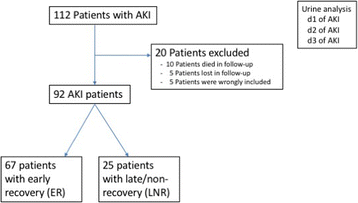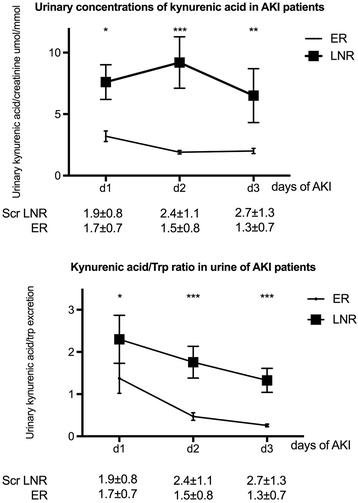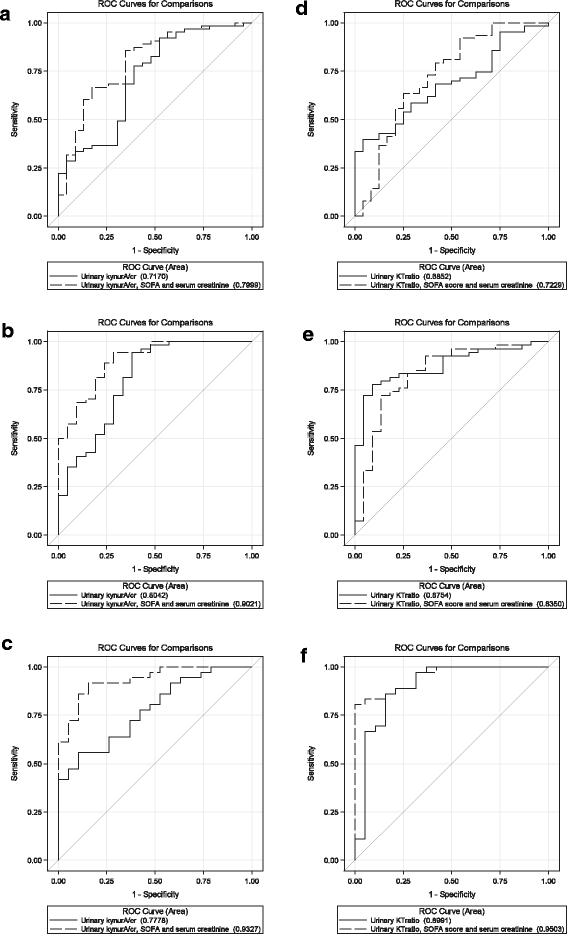Increased urinary excretion of kynurenic acid is associated with non-recovery from acute kidney injury in critically ill patients
- PMID: 29482511
- PMCID: PMC5828079
- DOI: 10.1186/s12882-018-0841-5
Increased urinary excretion of kynurenic acid is associated with non-recovery from acute kidney injury in critically ill patients
Abstract
Background: Acute kidney injury (AKI) is often observed in critically ill patients and is associated with high morbidity and mortality. Non-recovery from AKI has a negative impact on the prognosis of affected patients and early risk stratification seems key to improve clinical outcomes. We analyzed metabolites of a conserved key inflammatory pathway (i.e. tryptophan degradation pathway) in serial urine samples of patients with AKI.
Methods: One hundred twelve ICU patients with AKI were included in a prospective observational analysis. After exclusion criteria, 92 patients were eligible for analysis. Serial urine samples were collected and tryptophan levels including key tryptophan metabolites were measured using tandem mass spectrometry.
Results: Sixty-seven patients recovered in the first 7 days of AKI (early recovery, ER) whereas n = 25 had late-/non-recovery (LNR). Urinary concentrations of tryptophan, kynurenine, 3-OH anthranillic acid, serotonine, and kynurenine/tryptophan were significantly lower in LNR patients. In contrast, creatinine normalized excretion of kynurenic acid (KynA) was substantially increased in LNR patients (7.59 ± 6.81 vs. 3.19 ± 3.44 (ER) μmol/mmol, p < 0.005). High urinary KynA excretion was associated with higher RIFLE class, longer AKI duration, increased need for RRT, and 30-day mortality. Logistic regression revealed KynA as the single most important predictor of renal recovery on days 1 and 2 of AKI.
Conclusions: Increased urinary levels of kynurenic acid, a key inflammatory metabolite of the tryprophan degradation pathway, are associated with adverse renal and clinical outcomes in critically ill patients with AKI. Urinary KynA may serve as an early risk stratificator in respective patients with AKI.
Keywords: IDO; Inflammation; Intensive care unit; Kynurenines; Renal failure; Renal recovery; Tryptophan metablism.
Conflict of interest statement
Ethics approval and consent to participate
The study was approved by the local ethics committee and was performed in accordance with the Declaration of Helsinki. Written informed consent was obtained from all patients or respective legal substitutes.
Consent for publication
Not applicable.
Competing interests
The authors declare that they have no competing interest.
Publisher’s Note
Springer Nature remains neutral with regard to jurisdictional claims in published maps and institutional affiliations.
Figures



References
Publication types
MeSH terms
Substances
LinkOut - more resources
Full Text Sources
Other Literature Sources
Research Materials

